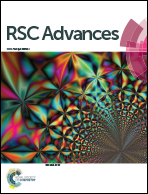Improved color rendering index of low band gap semi-transparent polymer solar cells using one-dimensional photonic crystals
Abstract
Neutral color semi-transparent polymer solar cells (STPSCs) have attracted a lot of attention due to their unique application in building integrated photovoltaic (BIPV) in recent years. Herein, we report a type of low band gap STPSCs with high color rendering index (CRI), which can be modulated by one-dimensional photonic crystals (1DPCs). To flatten transmitted light and eliminate chromatic aberration, the 1DPCs were integrated on top of the STPSCs as a wavelength-dependent filter. We have designed the centre wavelength of 1DPC at 520 nm to level the concavo-convex transmittance spectrum induced by the absorption of PSBTBT:PC60BM. By turning the pairs of 1DPCs, the optimal STPSCs with 3 pairs of 1DPC achieved an increased CRI from 77 to 91 under an AM 1.5G illumination light source, a suppressed chromaticity difference (DC) from 0.0308 to 0.0045 and a enhanced power conversion efficiency (PCE) from 3.43% to 4.01% compared to devices without 1DPC. Furthermore, we believe that this new method for STPSCs incorporating 1DPCs filters to balance the total transmittance spectrum and enhance the CRI will play a important role in future BIPV applications.


 Please wait while we load your content...
Please wait while we load your content...